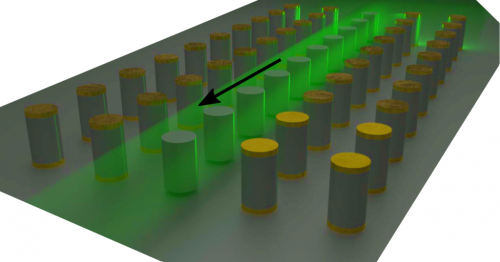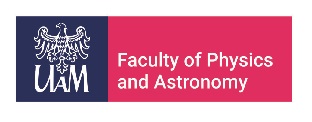Nanophotonics and metasurfaces

Merging classical photonics with the novel concepts of metamaterials and metasurfaces opens new avenues toward future photonic devices and technologies. We are working on the advanced concepts in the area of metamaterials and metasurfaces, in a wide frequency range that extends from terahertz to the visible.
Metasurfaces and meta-gratings for wavefront manipulation
Metasurfaces have the unprecedented potential in wavefront and polarization manipulation. The focus of our research is the metasurfaces capable of multifunctional operation. The elementary functionalities include deflection, splitting, focusing, retroreflection, demultiplexing, and spatial filtering. All these functionalities are highly demanded in photonics. Different functionalities may be achievable in the neighboring frequency ranges, or combined in one step, i.e. at a single frequency. Moreover, connection between the different functionalities are analyzed. Our general purpose within this research direction is to obtain multifunctionality in a simple structure. Although gradient metasurfaces with a large number of elements per supercell have been favorable for a long time, the potential of their simplified analogues that represent unitary and binary meta-gratings has not yet been properly explored. One of our research lines is related to the reflective unitary meta-gratings composed of Mie resonators (dielectric nanorods or nanocylinders) [1]. The meta-gratings concept has initially been developed for the near-infrared range and then transferred to other parts of electromagnetic spectrum. Its basics can also been utilized in the structures based on photonic crystals with low-order symmetry.
- M. Aalizadeh, A.E. Serebryannikov, E. Ozbay, and G.A.E. Vandenbosch, A simple Mie-resonator based meta-array with diverse deflection scenarios enabling multifunctional operation at near-infrared, Nanophoton. 9, 4589-4600 (2020), DOI: 10.1515/nanoph-2020-0386
Covered photonic waveguides
In addition to the free-standing metasurfaces, we study the metasurface and impedance surface based covers for photonic waveguides, like uniform dielectric and photonic-crystal-slab waveguides. The key idea is that the local volume defects can be replaced by local surface covers, while the capability of wave guiding, bending, and splitting is preserved [1]. Directional selectivity of resonances in nanocylinders that represent one of the options for a photonic-crystal slab composition, may yield functional selectivity in case of diverse modal properties.
- V. Vashistha, M. Krawczyk, A.E. Serebryannikov, and G.A.E. Vandenbosch, Light guiding, bending, and splitting via local modification of interfaces of a photonic waveguide, Opt. Lett. 44, 4725-4728 (2019), DOI: 10.1364/OL.44.004725
Terahertz photonics
The general purpose of our research in the area of terahertz photonics is application of the ideas related to multifunctionality, effect of proximity, coupling control and asymmetric transmission (AT), and epsilon-near-zero and near-zero-index behavior to the metasurfaces and other advanced structures in the frequency range that extends from 0.5 to 30 THz. Our specific aim is to obtain the switchable scenarios of wavefront and polarization manipulation. Therefore, it contains the detailed studies of the structures that comprise the components made of the thermally (vanadium dioxide, indium antimonide) or electrically (graphene) tunable materials. The common feature of the used tunable materials is that they may behave like dielectrics in some ranges of the external control parameter and like lossy metals in the other ranges. This feature is crucial for the capability of extreme reconfiguration. The terahertz range is expected to be perfectly suitable for it due to the variety of the potentially available materials. We use the concept which states that the different material phases may correspond to the totally different resulting functionalities. For instance, thermal switching between the metallic and the insulating phases of vanadium dioxide can result in switching between the regime of polarization state conversion (and related AT) and either frequency-independent, almost total transmission or frequency-dependent transmission (filtering) without polarization conversion. We work on implementation of the vacuum state concept, according to which some structural components electromagnetically disappear during transition from the metallic phase to the insulating phase, when the tunable material’s permittivity passes unity [1]. One more concept, on which we are currently working, is the concept of thermally tunable invisibility [2]. Another research line is dedicated to the terahertz applications of graphene. The effects of the proximity on the waves guided by graphene films and various mode hybridization scenarios are studied for a substrate/buffer layer that is made of a polar dielectric [3].
- A.E. Serebryannikov, A. Lakhtakia, M. Aalizadeh, E. Ozbay, and G.A.E. Vandenbosch, Temperature-mediated invocation of the vacuum state for switchable ultrawide-angle and broadband deflection, Sci. Rep. 8, 15044 (2018), DOI: 10.1038/s41598-018-32977-z
- A.E. Serebryannikov, K.B. Alici, E. Ozbay, and A. Lakhtakia, Thermally sensitive scattering of terahertz waves by coated cylinders for tunable invisibility and masking, Opt. Express 26, 1-14 (2018), DOI: 10.1364/OE.26.000001
- H. Hajian, A.E. Serebryannikov, A. Ghobadi, et al., Tailoring far-infrared surface plasmon polaritons of a single-layer graphene using plasmon-phonon hybridization in graphene-LiF heterostructures, Sci. Rep. 8, 13209 (2018), DOI: 10.1038/s41598-018-31049-6
Photonic structures with loss and gain
Our contribution to the studies of photonic structures with loss and gain is mainly connected to the mixing of Parity-Time-symmetric and Parity-Time-symmetry-broken phases, which is achieved by means of the polarization-converting surface components [1]. One of the focuses of this study is the case when the real part of permittivity of the loss and gain components is between 0 and 1. The studies of the structures with nonbalanced loss and gain are in progress.
- E. Ozgun, A.E. Serebryannikov, E. Ozbay, and C. Soukoulis, Broadband mixing of PT-symmetric and PT-broken phases in photonic heterostructures with a one-dimensional loss/gain bilayer, Sci. Rep. 7, 15504 (2017), DOI: 10.1038/s41598-017-14982-w

